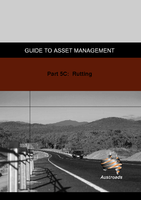Asset Management

- Publication no: AGAM05C-07
- ISBN: 978-1-921329-22-7
- Published: 1 October 2007
- Edition: 2
- Superseded
- PDF (free) Download
Guide to Asset Management Part 5C contains guidelines for, and background notes on, measurement and reporting of rutting or transverse profiles for road network management purposes in Australia and New Zealand. The guidelines define rutting as a longitudinal surface depression usually in a wheel path. They have been prepared in the context of measuring rutting either manually with a straight edge or using a vehicle mounted non-contact multi-sensor transverse profile measurement device. Regardless of the method of measurement, the guidelines express a preference for rut depth to be reported with reference to a 2 m straight edge. This is consistent with the HDM 4 approach. A standard reporting interval of 100 m is favoured. The guidelines discuss the frequency and extent of network rutting surveys, and are intended as a basis for the preparation of specifications for surveys of network rutting. Validation procedures for profilometers, and limits on repeatability and bias for rutting reports are included. The document also discusses the uses of rutting data in road pavement management at network and project levels and provides guidance on analysis techniques for rutting data for different applications. A glossary of terms used in measuring road pavement rutting is also included.
- 1. INTRODUCTION
- 1.1. Context within the Guide to Asset Management
- 1.2. Overview of Pavement Rutting
- 1.3. Objective
- 2. SPECIFICATION AND TEST METHOD
- 2.1. Definition of Rutting
- 2.2. Scope of Rutting Surveys
- 2.2.1. Preferred Lane
- 2.2.2. Sampling Interval and Frequency
- 2.3. Frequency of Rutting Surveys
- 2.4. Specification of Rutting Surveys
- 2.5. Data reporting
- 2.5.1. Reporting Interval
- 2.5.2. Reporting Parameters
- 3. TOOLS AND TECHNIQUES
- 3.1. Methods for Rutting Measurement
- 3.1.1. Determining Rut Depth Using Non-contact Methods
- 3.1.2. Preferred Methods for Determining Wheel Path and Lane Rut Depths
- 3.2. Technologies for Rutting Surveys
- 3.2.1. Manual Methods for Measuring Rutting
- 3.2.2. Automated Methods for Measuring Rutting
- 3.3. Equipment Conditioning and System Performance
- 4. DATA QUALITY AND VALIDATION
- 4.1. Validation of Distance Measurement
- 4.2. Validation of Rutting Measurement (Non-contact Methods)
- 4.3. Repeatability and Bias (Non-contact Methods)
- 5. ANALYSIS
- 5.1. Assessing the Validity of Rutting Data
- 5.2. Distribution Analysis
- 6. APPLICATION
- 6.1. Network Screening
- 6.2. Performance Measures
- 6.3. Network Level Monitoring and Performance Modelling
- 6.4. Managing Maintenance Contracts
- 6.5. Intervention Levels
- 6.6. Decision-Support Tools
- 7. PROJECT LEVEL APPLICATION
- 7.1. Rutting Data Collection at the Project Level
- 7.2. Assessment of Pavement Strength
- 7.3. Rutting Data as a Diagnostic Tool
- 7.4. Selection of Maintenance Treatment
- REFERENCES
